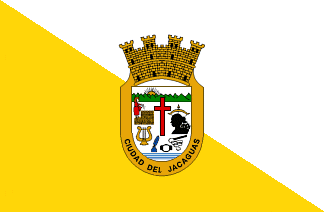 (2:3)
(2:3)by Blas Delgado, 16 November 2004

Last modified: 2004-11-20 by dov gutterman
Keywords: puerto rico | juana diaz | jacagua | la plata |
Links: FOTW homepage |
search |
disclaimer and copyright |
write us |
mirrors
 (2:3)
(2:3)
by Blas Delgado, 16 November 2004
See also:
Other sites:
Flag adopted: 25 April 1978. The Coat of Arms has the symbols
of the wards of the pueblo. On the Coat of Arms on the flag the
name 'Jacagua'. Ciudad del Jacaguas is a nickname for the pueblo,
after the name of an Indio and the river which flows through it.
Juana Díaz was founded 1798; it is in south central Puerto Rico,
just east of Ponce. There are 46,829 Juanadinos. see also image
at <www.qsl.net>.
Jarig Bakker, 1 Febuary 2000
Juana Díaz - The white triangle is "Símbolo de La
Plata", or literally 'symbol of silver' , making reference
to La Plata River, the longest river in Puerto Rico.
Blas Delgado, 16 April 2001
Jacaguas is the name of the River of Juana Díaz. Jacaguax was
the name of a Cacique Taino and the river has the name Jacaguas
in honor of those Cacique.
Nelson L. Román, 7 July 2004
jd.gif)
by Nelson L. Román, 4 July 2004
From <www.juanadiaz.org>:
The Four Castles - Represent that Juana Díaz
reached the stature of city. Cities have five castles in their
coat of arms, villages have four and smaller towns have three.
The Sun - Symbolizes a new horizon, hope in the
formation of a town. The sun in the coat of arms has thirteen
rays, each representing a ward of Juana Díaz.
Montains - Thirteen knolls stand out in the coat
of arms symbolizing each of the thirteen wards or barrios of
Juana Díaz. The mountains also symbolize that Juana Díaz has
been one of the richest mineral towns in Puerto Rico. Juana Díaz
produces high quality marble on a commercial scale.
Woman - Represents the name of the woman that
gave foundations to the town - Mrs. Juana Díaz - with her hands
the woman strews thirteen grains of corn into thirteen furrows,
symbolizing the seeds that germinated and were the base for the
foundation and growth of our town. The woman dresses as those of
her time.
The Nazarene Cross - It is in the center of the
coat of arms. It stands out subtly between furrows and space,
symbolizing the union of two races by means of the inalienable
bond of the Christian faith. The cross also simbolizes the
western Christian culture.
The Harp and Quill Pen - The harp represents the
music, the quill pen dipped in the ink well represents the verse,
the poetry. Juana Díaz has generously given distinguished poets
to Puerto Rican literature. Among these are Luis Lloréns Torres,
Tomas Carrión Maduro, Luis Felipe Dessús, Josefina Lloréns
Torres, Mario Braschi, Cesáreo Rosa Nieves, Arturo Gómez Costas
and other contemporaries.
The Shackle and the Whip - Juana Díaz is known
in history as the martyr of '87 because the most heinous,
repressive institution known at the time was enforced in our town
- "El Componte". It was in Juana Díaz where liberal
politicians and dedicated patriots were martyred because they
fought against the tyranny imposed by General Romualdo Palacios.
Palacios was the most tyrannical and cruel of all the governors
of our nation. "El Componte", a military tribunal, was
used to quiet the rebel voices of those who loved law and order.
The Native Element - Represents the native who
settled the village before the arrival of the white man. The
native carries on his back thirteen sheathed arrows and a bow,
and an arrow on his head. The bow and arrow represent the only
effective means of defense useful for survival.
Ciudad del Jacaguas - This is the name by which
Juana Díaz was known in the past. Many people knew Juana Díaz
as the city of Jacaguas, but Luis Lloréns Torres dubbed it
"La Versalles de Ponce" (Ponce's Versailles).
Nelson L. Román, 7 July 2004